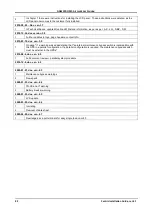
GAMATRONIC,
A
S
OLAR
E
DGE
D
IVISION
Centric Installation Guide, rel. 4.7
70
8.
C
IRCUIT BREAKER SELECTIVITY
When discussing power distribution, " selectivity " (also referred to as
“discrimination”) is the selection and
arrangement of circuit breakers such that in the event of a short circuit or overload in the line, the circuit
breaker closest to the short will be tripped and the upstream circuit breakers remain unaffected.
In a UPS, the electrical circuit of the bypass ac input line includes the main circuit breaker feeding the UPS
and the circuit breaker distributing power to the load.
The UPS load is normally fed from the UPS's inverter. When a short circuit occurs, the UPS detects the
short circuit and switches the load to the bypass line. During the short circuit, the current flows through the
bypass line's main circuit breaker and continues through the other circuit breakers in series to the load that
is the source of the short circuit.
A problem that can arise in such a situation is how to prevent the main circuit breaker from tripping before
the downstream circuit breaker closest to the load is tripped.
As an example, Figure 56 shows a typical UPS feeding a number of loads. When a short circuit occurs in
Load 2, the system switches the load to the bypass line. In the example, the bypass line includes CB01,
CB03, and CB05. The problem is how to prevent CB01 and CB03 from tripping open before CB05 trips
open.
Figure 56: A UPS's bypass circuit
Selection of circuit breakers to achieve discrimination involves the consideration of two factors: thermal
tripping and magnetic tripping. Circuit breakers can have one or both of these tripping characteristics.
Magnetic tripping is activated immediately when the current though the circuit breaker exceeds a specific
limit. Magnetic tripping can include a deliberate delay, depending on the design of the specific circuit
breaker chosen.
Thermal tripping responds, with a delay, to lower-level, longer-term current excesses. Thermal tripping can
be useful on circuits that are subject to expected short-term current overload, such as when a load with
high-inrush current is turned on. In such a case you would only want the circuit breaker to trip if the current
overload continued for an abnormal length of time.
Using Figure 56 as an example, optimal discrimination of circuit breakers in series can be achieved by
choosing them in such a way that when a short circuit occurs, the response of circuit breaker feeding the
bypass line (CB01) line will be based on thermal (slower-acting) tripping, while the circuit breaker closest to
the short circuit (CB05) will respond based on magnetic (instantaneous) tripping. In most cases we would
want the intermediate circuit breaker (CB03) to respond thermally to a short in Load 2, but with a shorter
delay than that of CB01.
See Table 2 for maximum rectifier input current values and maximum bypass input current values.
See Table 3 for recommended circuit breaker ratings.
In order to protect the UPS's bypass contactor and also the main input of the UPS, for all scenarios
including short circuit, Gamatronic recommends the following:
The circuit breaker that feeds the bypass input line and the circuit breaker feeding the main input of
UPS shall have no magnetic protection delay, or a maximum magnetic protection delay of 50 msec.



























